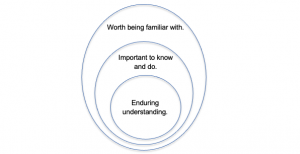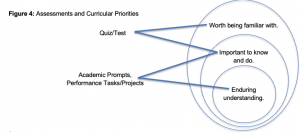39 Backward Design
Teaching Strategies: Backward Design
- Author: Elizabeth Harsma
- Editors: Carrie Miller, Michael Manderfeld
Backward design is a process that educators use to design learning experiences and instructional techniques to achieve specific learning goals.
- Begin this process by determining the desired end results for the course – what do you want the students to know?
- Then determine how to measure (assess) that the material has been learned – how will you know the students have learned?
- Finally, map the course to scaffold appropriate instructional activities.
Backward design can be used for designing a course, a module/unit/section, or even a single class period.

Figure 1: Stages of Backward Design
Note: Adapted from Wiggins, Grant P., and Jay McTighe (1998) Understanding by Design.
Applying Backward Design
Backward Design can be thought of as task analysis, similar to the process an architect, engineer, or graphic arts designer might use for a new project. The analysis begins by identifying the desired outcome of the task, followed by determining how you will measure success, and finally planning the steps needed to reach that result. As you begin developing a course, unit, or lesson plan for a single class session, you might use the following steps and questions to help guide the backward design process:
Stage 1: Identify desired results – What should the students be able to do, demonstrate, or accomplish at the end of the lesson, unit/module, or course?
Because there is a vast amount of content and skills that could be addressed in any area of study, an instructor must identify curricular priorities for each course, unit/module, or lesson. You might use the following process for narrowing and selecting outcomes (See Figure 2):
- Worth being familiar with: During the course/lesson what do you want students to hear, read, see, research, or encounter? This represents a wide range of topics, concepts, skills in your course that students should have some familiarity with. Broad knowledge that could be assessed with traditional quizzing or exams.
- Important to know and do: What are the key concepts and skills that students must have to be successful in the course or lesson? Another way to think about this is that you would consider these to be pre-requisites to being able to successfully complete key performances.
- Enduring understanding: What concepts and skills and “big ideas” do we want students to retain and be able to apply to their real-world experiences long after the course ends, and details are forgotten?

Figure 2: Process to Identify Curricular Priorities
Note: Adapted from Wiggins, Grant P., and Jay McTighe (1998) Understanding by Design.
You might consider using the following filter questions to help you determine what topics might fall into the “enduring understanding” category:
- Filter 1: To what extent does the concept/skill represent a big idea that has enduring value beyond the classroom? These are transferrable theories and skills that impact the quality of life beyond the course itself.
- Filter 2: To what extent is the concept/skill central to your discipline? Does the topic represent an authentic learning experience that represents how the discipline is applied in the real world or how knowledge is generated in the field?
- Filter 3: What concepts are particularly difficult to grasp, harbor misconception, or are foundational principles that may not be obvious to learners?
- Filter 4: What principles and skills are particularly engaging for students? What topics can be connected to big ideas and learners’ own interests and experiences?
Take Action
Review this Writing Measurable Learning Outcomes document. Apply Stage 1 of Backward Design: identify curricular priorities, ask filter questions to determine enduring understanding topics, and write measurable outcomes for a course, unit, or lesson.
Stage 2: Determine acceptable evidence – How will you know your students have successfully met the outcomes, are competent in the skill, and/or can apply the knowledge or concepts in the course/unit/lesson?
The next step in backward design is to determine what evidence to collect that will allow you to know what your students have accomplished. Evidence refers to the range of formal and informal assessments throughout a lesson, unit, or course. A common misconception is that evidence is only end-of-semester tests or projects. This is not the case. You might consider using assessments methods from across the following continuum in your course design:

Figure 3: Assessment Method Continuum
Note: Adapted from Wiggins, Grant P., and Jay McTighe (1998) Understanding by Design.
Quiz/Test: Simple, content-focused items that evaluate for facts, concepts.
- multiple-choice, short answer.
- single best answer response
- scored using an answer key
- questions are not known to students prior to the exam
Academic Prompts: Open-ended, questions or problems that require critical thinking.
- ill-structured problem requiring analysis, synthesis, evaluation
- open, no single best answer, require justification for answer/methods
- scored based on criteria and performance standards
- may or may not be known to students prior
Performance Tasks/Projects: Complex authentic tasks that mirror real-world experiences and issues.
- Real or simulated setting, with similar constraints and benefits
- Students must address an identified audience
- Must accomplish a specific purpose as related to the audience
- Can be personalized by the student
- Tasks, criteria, and standards are known in advance

Note: Adapted from Wiggins, Grant P., and Jay McTighe (1998) Understanding by Design.
Stage 3: Plan Learning Experiences and Instruction – What concepts and principles, materials, learning activities, and instructional experiences/coaching do students need in order to successfully accomplish the performance assessment tasks of the course?
The final step in Backward Design is to plan the activities and practices that students need that will help them be successful in the informal and formal assessment tasks you’ve selected. Alignment of the entire design from outcomes to assessments and activities should also be addressed at this stage as well.
Take Action
Review this Mapping Your Course document. Apply Stage 2 and 3 of Backward Design: Determine how you will measure achievement of the outcomes using the assessment continuum, select learning activities that align with those assessments, and complete a map of your course/unit/lesson.
Resources
This section outlines some additional resources you might begin to think about using to adopt this teaching strategy:
On the Web
Even more resources to introduce you to the application of Backward Design:
*Note that you must log in with your StarID/MavMail credentials in order to view these videos
References
Wiggins, Grant P., and Jay McTighe. Understanding by Design. Association for Supervision and Curriculum Development, Alexandria, Va, 1998.

